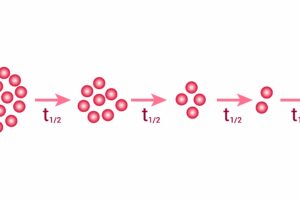What Is the Half-Life of Cf-252?
Do atoms die? Rather than dying, certain atoms experience a radioactive decay process. Every atom save hydrogen contains neutrons, or electrically neutral subatomic particles. But what do neutrons do? Together with protons, neutrons make up an atom’s nucleus. However, some of these neutrons float freely, degrading radioactively into other particles within a short timeframe—though physicists disagree on the exact timing.
Who discovered the neutron? Theorized in the 1920s, it wasn’t until 1932 that Sir James Chadwick, a British physicist, gathered evidence from experimentation that provided more definitive proof of the existence of these particles. Then, in 1950, the radiation laboratory at the University of California at Berkeley discovered a synthetic radioactive element that became known as californium.
An isotope occurs when an element’s atoms all have the same amount of protons but a differing amount of neutrons. One of californium’s 20 isotopes, radioactive californium-252 (Cf-252), has proven helpful in various commercial, industrial and nuclear applications for its stability and efficient neutron-emitting capability. Cf-252 began as an isolated sample of Curium that was neutron-irradiated, and, while it is rare because it is not naturally occurring, particle accelerators and high-flux isotope reactors can utilize neutron bombardment to produce it.
Continue reading to learn more about neutrons and Cf-252, half-life, and the special considerations required for handling or transporting radioactive isotopes.
Lifetime of a Neutron
There’s no definitive answer as yet on the exact time period of a neutron’s lifetime. Physicists have used various laboratory approaches for years to determine it but they continue to yield differing results. In one of their attempts, the average lifetime came to 14 minutes and 39 seconds. In another test, however, the neutron life span came in at 14 minutes and 47 seconds
Despite the discrepancies, it is important for researchers to narrow down the life of a neutron. This can help them understand how the universe came into being after the Big Bang about 13.8 billion years ago. They particularly would like to know the volume of light elements such as hydrogen and helium that formed within the next few minutes after the event. Determining neutron lifetime would also assist scientists in the study of physics and determining other subatomic particle measurements.
What Is a Half-Life?
Half-life is the time period needed for half of a radioactive sample’s atomic nuclei to degrade. It will spontaneously become a different nuclear species, giving off energy and particles as this occurs. The term can also refer to the time that it takes for there to be a 50% reduction of a radioactive material’s per-second disintegrations.
Even though a free neutron’s average half-life is 10.2 minutes, most are stable within nuclei with specific energy levels. For neutron decay to occur, protons need an available lower energy state than the initial energy state of the neutrons. This is referred to as bound neutron decay.
Half-Life of Californium-252
Scientists determined the half-life of californium-252 by examining the ratio of activity in a manganese-sulfate bath via the isotope’s spontaneous fission neutron source with the photo-neutron source of the National Bureau of Standards. This method measures the rate change in emissions over 1.77 half-lives for the Cf-252 source. Researchers determined that, for Cf-252, the half-life is 2.647 years.
Work With Frontier Technology for Your Nuclear Needs
Nuclear power usage is up worldwide, and so its generation is important in modern operations for safe and efficient power supply. Nuclear energy has a low carbon footprint with no emissions, and it’s reliable yet economical. With the short half-life of Cf-252, it stands as a suitable initiator of the nuclear fission process in reactors.
However, as a highly radioactive isotope, Cf-252 requires specialized neutron-designated shipping containers for transport. At Frontier Technology Corporation, we offer high-quality, single- or double-encapsulated nuclear capsules that meet USDOT IAEA Special Form certification requirements. Since 1984, FTC has built a reputation as a trusted neutron-emitting source supplier and manufacturer of radioactive shipping containers for diverse industries across the globe.
We design and customize our capsules to meet customer specifications, and our expert welders utilize TIG and circumferential seal welding for tolerances of ±10%. Our company is licensed by the Ohio Department of Health (ODH), and each of our products and services adheres to strict industry regulations from organizations including:
- Nuclear Regulatory Commission (NRC)
- ASTM
- ANSI
We also carry out rigorous testing to ensure safety, reliability, and a high level of integrity in our products and services. For more information about our capabilities, cost-effective neutron sources, and Type A customized radioactive shipping container solutions, contact us today.

